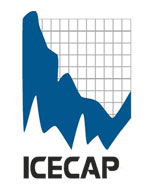Source: The Hill
Six House Democrats, led by Rep. Dennis Kucinich (D-Ohio), want to set up a “Reasonable Profits Board” to control gas profits.
The Democrats, worried about higher gas prices, want to set up a board that would apply a “windfall profit tax” as high as 100 percent on the sale of oil and gas, according to their legislation. The bill provides no specific guidance for how the board would determine what constitutes a reasonable profit.
The Gas Price Spike Act, H.R. 3784, would apply a windfall tax on the sale of oil and gas that ranges from 50 percent to 100 percent on all surplus earnings exceeding “a reasonable profit.” It would set up a Reasonable Profits Board made up of three presidential nominees that will serve three-year terms. Unlike other bills setting up advisory boards, the Reasonable Profits Board would not be made up of any nominees from Congress.
The bill would also seem to exclude industry representatives from the board, as it says members “shall have no financial interests in any of the businesses for which reasonable profits are determined by the Board.” According to the bill, a windfall tax of 50 percent would be applied when the sale of oil or gas leads to a profit of between 100 percent and 102 percent of a reasonable profit. The windfall tax would jump to 75 percent when the profit is between 102 and 105 percent of a reasonable profit, and above that, the windfall tax would be 100 percent. The bill also specifies that the oil-and-gas companies, as the seller, would have to pay this tax.
Kucinich said these tax revenues would be used to fund alternative transportation programs when oil-and-gas prices spike.
“Gas prices continue to rise, creating a hardship for the American people,” he said. “At the same time, oil companies are making record profits gouging their customers. This bill would tax only the excess profits and create forward-thinking transportation alternatives.”
Specifically, he said the money would be used to fund a tax credit on the purchase of fuel-efficient cars and set up a grant program for mass transit programs when oil-and-gas prices are high.
The bill does not estimate the size of these grants or the amount of money that might be collected through the tax.
Co-sponsoring the bill are five other Democrats: Reps. John Conyers Jr. (Mich.), Bob Filner (Calif.), Marcia Fudge (Ohio), Jim Langevin (R.I.), and Lynn Woolsey (Calif.).
SPPI Comment:
For the word “oil” substitute “gas” or “coal”.
Game plan: With both foreign policy and domestic energy policy, [1] drive the costs of fossil fuels into the stratosphere (as promised during Obama campaign) and [ 2] then tax the non-inflation adjusted revenue, [3] drive more Americans into fuel poverty and welfare dependency,[4] redistribute funds to crony capitalist friends and radical environmentalist allies [5] so they all can kick-back campaign contributions to use for the “politics of personal destruction” campaign ads against any opponent. But do not reduce local, state and federal fuel taxes.
By Joe Bastardi, Weatherbell Analytics
When the PDO turned cold, most of the meteorological and climate community understood that the pattern was turning very similar the last time of the PDO reversal, the 1950s, and it was a matter of time before the global temperatures, which have leveled off, would start falling in the same herby jerky fashion they had risen when the PDO turned warm at the end of the 1970s. I am not going to rehash the sordid details of how the AGW crowd simply ignores the major drivers of a cyclical nature. We all know that. Nor am I going to question them as to why they believe a trace gas like CO2 (needed for life on the planet) with a specific gravity of 1.5 as compared to the atmospheres 1.0, was going to mix with air in a way to affect the earth’s temperatures. Instead I am going to drive home points I have been making since 2007 and are now dramatically validating.
The La Ninas of 2008-09 and now this one had rapid mid level temperature drops that followed their onset and this years was nothing short of the most dramatic mid tropospheric drop since the start of the millennium. It is much more plausible to believe that rapid cooling in the mid levels would have an effect at leading to extremes, rather than what the warmingistas claim, which of course is anything that happens. In any case, one very interesting level that cooled to record cold levels was 400 mb, the very levels that the so called trapping hot spots were going to show up because of CO2...again a neat trick since somehow CO2 was going to defy the laws of Gravity, since, as mentioned above, its specific gravity is higher than the atmosphere (of course even if it was, it a) has not been proven to cause warming and b) man’s contribution is so tiny as to render it a non item anyway in climate considerations.
However first came the flip in the PDO, seen nicely here on the Multivariate Enso Index chart, which clearly illustrates the colder Pacific when the earth was colder, the start of the warming period coinciding with the satellite era, and now.

Now from the AMSU site, the amazing one year drop in temperature, the orange tan line being after the El Nino of 2009/10, the purplish line this past year and one can see the green this yearÖ we are near record cold levels again.
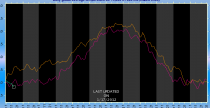
600 mb (14,000 feet) (enlarged)
And oh my myÖthe trapping hot spot itself.. 400mb or 25,000 feet… again record or near record cold

enlarged)
But the 2 meter temperatures, being in the boundary layer, do not respond as fast as the ocean, or a transparent atmosphere above
Nevertheless three downturns in a jagged fashion started predictably after the last El Nino now falling again in fits and spurts through December.
From Dr Roy Spencers site:
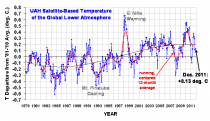
(enlarged)
In May, I forecasted the global temperatures to fall to -0.15C in one of the months - Jan, Feb or Mar this year, and perhaps as low as levels we saw in the 2008 La Nina. A rapid free fall has begun. Dr. Ryan Maue at his site (http://policlimate.com/weather/) maintains a plethora of useful forecast information including GFS global temp projections over the next 16 days.
They have been routinely reading greater than 0.2 C below normal and I suspect the Jan reading will plummet quite a bit from December with February even lower. An example of this can be seen with these two charts off Ryanís site,
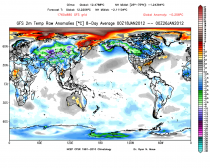
-0.258 C globally for 2 meters. (enlarged)
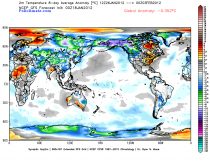
Day 8.5-16 a whopping -0.352 C (enlarged)
The reason the arctic looks warm is that it has been stormy, and when itís windy the air is well mixed and so the temperatures are not as low as if itís calm, but itís still frigid. Notice in the second map, that the arctic cools because the arctic oscillation is starting to go negative, leading to higher pressures and lighter winds. But the most astounding aspect of this is the northern hemisphere mid latitude temperatures, at -2.1 C.
Currently, with gas so high because we are being handcuffed by an administration that wonít drill (if gas was a 1.50 lower, it would be worth a half trillion dollars to the economy) and an EPA that is causing untold economic damage (I would conservatively etiolate a half trillion dollars, from jobs lost to burdensome regulations) along with a 100 billion dollar subsidy to fight global warming world wide, it is costing each ACTUAL TAX PAYER close to 7000 dollars (1.1 trillion divided by 150 million tax payers).
One has to wonder, how even the most dogmatic of them don’t look at the actual facts, how they can continue to carry on their denial while the results of such things handcuff the American economy and cause untold misery for many as our wealth is not only redistributed, but dwindles. One can only conclude this is being done on purpose, and with purpose.
See By Joe Bastardi, Weatherbell Analytics
When the PDO turned cold, most of the meteorological and climate community understood that the pattern was turning very similar the last time of the PDO reversal, the 1950s, and it was a matter of time before the global temperatures, which have leveled off, would start falling in the same herby jerky fashion they had risen when the PDO turned warm at the end of the 1970s. I am not going to rehash the sordid details of how the AGW crowd simply ignores the major drivers of a cyclical nature. We all know that. Nor am I going to question them as to why they believe a trace gas like CO2 (needed for life on the planet) with a specific gravity of 1.5 as compared to the atmospheres 1.0, was going to mix with air in a way to affect the earth’s temperatures. Instead I am going to drive home points I have been making since 2007 and are now dramatically validating.
The La Ninas of 2008-09 and now this one had rapid mid level temperature drops that followed their onset and this years was nothing short of the most dramatic mid tropospheric drop since the start of the millennium. It is much more plausible to believe that rapid cooling in the mid levels would have an effect at leading to extremes, rather than what the warmingistas claim, which of course is anything that happens. In any case, one very interesting level that cooled to record cold levels was 400 mb, the very levels that the so called trapping hot spots were going to show up because of CO2...again a neat trick since somehow CO2 was going to defy the laws of Gravity, since, as mentioned above, its specific gravity is higher than the atmosphere (of course even if it was, it a) has not been proven to cause warming and b) man’s contribution is so tiny as to render it a non item anyway in climate considerations.
However first came the flip in the PDO, seen nicely here on the Multivariate Enso Index chart, which clearly illustrates the colder Pacific when the earth was colder, the start of the warming period coinciding with the satellite era, and now.

Now from the AMSU site, the amazing one year drop in temperature, the orange tan line being after the El Nino of 2009/10, the purplish line this past year and one can see the green this yearÖ we are near record cold levels again.

600 mb (14,000 feet) (enlarged)
And oh my myÖthe trapping hot spot itself.. 400mb or 25,000 feet… again record or near record cold

enlarged)
But the 2 meter temperatures, being in the boundary layer, do not respond as fast as the ocean, or a transparent atmosphere above
Nevertheless three downturns in a jagged fashion started predictably after the last El Nino now falling again in fits and spurts through December.
From Dr Roy Spencers site:

(enlarged)
In May, I forecasted the global temperatures to fall to -0.15C in one of the months - Jan, Feb or Mar this year, and perhaps as low as levels we saw in the 2008 La Nina. A rapid free fall has begun. Dr. Ryan Maue at his site (http://policlimate.com/weather/) maintains a plethora of useful forecast information including GFS global temp projections over the next 16 days.
They have been routinely reading greater than 0.2 C below normal and I suspect the Jan reading will plummet quite a bit from December with February even lower. An example of this can be seen with these two charts off Ryanís site,

-0.258 C globally for 2 meters. (enlarged)

Day 8.5-16 a whopping -0.352 C (enlarged)
The reason the arctic looks warm is that it has been stormy, and when itís windy the air is well mixed and so the temperatures are not as low as if itís calm, but itís still frigid. Notice in the second map, that the arctic cools because the arctic oscillation is starting to go negative, leading to higher pressures and lighter winds. But the most astounding aspect of this is the northern hemisphere mid latitude temperatures, at -2.1 C.
Currently, with gas so high because we are being handcuffed by an administration that wonít drill (if gas was a 1.50 lower, it would be worth a half trillion dollars to the economy) and an EPA that is causing untold economic damage (I would conservatively etiolate a half trillion dollars, from jobs lost to burdensome regulations) along with a 100 billion dollar subsidy to fight global warming world wide, it is costing each ACTUAL TAX PAYER close to 7000 dollars (1.1 trillion divided by 150 million tax payers).
One has to wonder, how even the most dogmatic of them don’t look at the actual facts, how they can continue to carry on their denial while the results of such things handcuff the American economy and cause untold misery for many as our wealth is not only redistributed, but dwindles. One can only conclude this is being done on purpose, and with purpose.
See PDF with enlarged images.
Source: CNS News
Mark Levin says America cannot at the same time have a Constitution and an Environmental Protection Agency (EPA) that is doing what the EPA is doing today.
Levin made the observation in an interview with CNSNews.com about his new book, “Ameritopia: The Unmaking of America.”
Modern American liberals, who are Utopias, Levin said, aim to erode the separation of powers built into the U.S. Constitution so that a “relative handful of masterminds” can tell everybody else what to do.
“This erosion has been going on for about a hundred years,” said Levin. “It’s at a much faster pace right now and thereís a reason for this - because you can’t have constitutionalism and utopianism.”
“The purpose of the Constitution is to have a limited central government where the sovereignty remains with the individual and the people and the states,” said Levin. “The purpose of utopianism is the opposite of all that. It’s a relative handful of masterminds and their massive army of bureaucrats and their experts advising them from the colleges and so forth on how to run society.
“You cannot have an EPA and a Constitution at the same time doing what this EPA is doing,” Levin told CNSNews.com.
“You cannot have an NLRB deciding who gets to work where, how, and when, and at the same time follow the Constitution,” he said.
“You cannot have a tax code that serves basically the purpose of redistributing wealth, which is one of the things that Marx was pushing for so strongly, and at the same time be arguing about limited government and constitutionalism,” he said.
“The utopians reject history. Everything begins today,” said Levin. “The models they want to put in place begin today. So why anybody thinks they’re going to respect the Constitution when they don’t respect the rest of history is beyond me.”
In “Ameritopia: The Unmaking of America,” released Monday, Levin compares the Utopian political philosophy behind modern American liberalism with the vision of natural law, God-given rights and limited government that inspired the Founding Fathers to write the Declaration of Independence and the Constitution.
The Supreme Court last week heard arguments in the case of Sackett v. Environmental Protection Agency. The case was brought by an Idaho couple, Mike and Chantell Sackett, who were told by the EPA that they could not build a home on their own lot because the EPA said it might be a wetland - and that they could face a fine of $37,000 per day for defying the EPA’s order.
